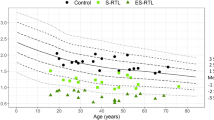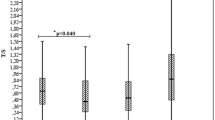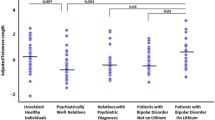Abstract
Backgrounds and aims
Telomere attrition proceeds with the aging process, and is also associated with aging disease conditions, such as Alzheimer’s disease (AD). The aging process also affects subtelomeric methylation status. In the present study, the telomere length and the subtelomeric methylation status in female AD patients were analyzed to see how AD affects telomere structure.
Methods
Terminal restriction fragment length of 23 AD patients’ peripheral leukocytes was analyzed with methylation sensitive- and insensitive-isoschizomer by Southern blot.
Results
AD patients were found to have normal mean telomere lengths (controls; 6.4 ± 0.9 kb, AD; 6.1 ± 0.8 kb, p = 0.131), a proportionally decreased number of the longest telomeres (>9.4 kb) (controls; 30.3 ± 7.9 %, AD; 24.4 ± 8.3 %, p = 0.013), increased medium-sized telomeres (controls; 51.7 ± 3.3 %, AD 55.5 ± 6.4 %, p = 0.015) and unchanged numbers of the shortest telomeres (<4.4 kb) (controls; 18.0 ± 7.8, AD; 20.2 ± 8.9 %, p = 0.371) in their peripheral leukocytes. The subtelomeres of telomeres in the shortest range (<4.4 kb) were more methylated in AD subjects than in controls (controls; 0.21 ± 0.23, AD; 0.41 ± 0.26, p = 0.016).
Conclusions
These results may indicate that AD contributes to the loss of cells bearing the shortest telomeres, with hypomethylation of subtelomeres occurring in addition to telomere attrition, resulting in an apparent normal mean telomere length in AD patients. The relatively high subtelomeric methylation status of the shortest telomeres in peripheral blood leukocytes may be a characteristic of AD. This report demonstrates that the epigenetic status of the telomeric region is affected by disease conditions.


Similar content being viewed by others
References
Blackburn EH (1991) Structure and function of telomeres. Nature (London) 350:569–573
Zakian VA (1995) Telomeres: beginning to understand the end. Science 270:1601–1607
Aubert G, Lansdorp PM (2008) Telomeres and aging. Physiol Rev 88:557–579
Guan JZ, Maeda T, Sugano M, Oyama J, Higuchi Y, Makino N (2007) Change in the telomere length distribution with age in the Japanese population. Mol Cell Biochem 304:253–260
Okuda K, Khan MY, Skurnick J et al (2000) Telomere attrition of the human abdominal aorta: relationships with age and atherosclerosis. Atherosclerosis 152:391–398
Uziel O, Singer JA, Danicek V et al (2007) Telomere dynamics in arteries and mononuclear cells of diabetic patients: effect of diabetes and of glycemic control. Exp Gerontol 42:971–978
Panossian LA, Porter VR, Valenzuela HF et al (2003) Telomere shortening in T cells correlates with Alzheimer’s disease status. Neurobiol Ageing 24:77–84
Valdes AM, Andrew T, Gardner JP et al (2005) Obesity, cigarette smoking, and telomere length in women. Lancet 366:662–664
Epel ES, Blackburn EH, Lin F et al (2004) Accelerated telomere shortening in response to life stress. Proc Natl Acad Sci USA 101:17312–17315
Guan JZ, Maeda T, Sugano M et al (2008) A percentage analysis of the telomere length in Parkinson’s disease patients. J Gerontol A Biol Sci Med Sci 63A:467–473
Guan JZ, Maeda T, Sugano M et al (2007) An analysis of telomere length in sarcoidosis. J Gerontol A Biol Sci Med Sci 62:1199–1203
Elgin SC (1996) Heterochromatin and gene regulation in Drosophila. Curr Opin Genet Dev 6:193–202
Benetti R, García-Cao M, Blasco MA (2007) Telomere length regulates the epigenetic status of mammalian telomeres and subtelomeres. Nat Genet 39:243–250
Yehezkel S, Segev Y, Viegas-Pe′quignot E (2008) Hypomethylation of subtelomeric regions in ICF syndrome is associated with abnormally short telomeres and enhanced transcription from telomeric regions. Hum Mol Genet 17:2776–2789
Brock GJ, Charlton J, Bird A (1999) Densely methylated sequences that are preferentially localized at telomere-proximal regions of human chromosomes. Gene 240:269–277
Hansen RS, Wijmenga C, Luo P et al (1999) The DNMT3B DNA methyltransferase gene is mutated in the ICF immunodeficiency syndrome. Proc Natl Acad Sci USA 96:14412–14417
Maeda T, Guan JZ, Oyama J et al (2009) Age-related changes in subtelomeric methylation in the normal Japanese population. J Gerontol A Biol Sci Med Sci 64:426–434
Maeda T, Guan JZ, Oyama J et al (2009) Aging-associated alteration in subtelomeric methylation in Parkinson’s disease. J Gerontol A Biol Sci Med Sci 64:949–955
Maeda T, Guan JZ, Higuchi Y, Oyama J, Makino N (2009) Age-related alterations in subtelomeric methylation in sarcoidosis patients. J Gerontol A Biol Sci Med Sci 64:752–760
American Psychiatric Association (1994) Diagnostic and statistical manual of mental disorders, 4th edn. Washington, DC, pp 104–152
Hemann MT, Strong MA, Hao LY et al (2001) The shortest telomere, not average telomere length, is critical for cell viability and chromosome stability. Cell 107:67–77
Cherif H, Tarry JL, Ozanne SE et al (2003) Ageing and telomeres: a study into organ- and gender-specific telomere shortening. Nucl Acids Res 31:1576–1583
Price DL, Tanzi RE, Borchelt DR et al (1998) Alzheimer’s disease: genetic studies and transgenic models. Annu Rev Genet 32:461–493
Agostinho P, Cunha RA, Oliveira C (2010) Neuroinflammation, oxidative stress and the pathogenesis of Alzheimer’s disease. Curr Pharm Des 16:2766–2778
Zekry D, Herrmann FR, Irminger-Finger I et al (2010) Telomere length is not predictive of dementia or MCI conversion in the oldest old. Neurobiol Aging 31:719–720
Zekry D, Herrmann FR, Irminger-Finger I et al (2010) Telomere length and ApoE polymorphism in mild cognitive impairment, degenerative and vascular dementia. J Neurol Sci 299:108–111
Thomas P, O’ Callaghan NJ, Fenech M (2008) Telomere length in white blood cells, buccal cells and brain tissue and its variation with ageing and Alzheimer’s disease. Mech Ageing Dev 129:183–190
Franco R, Schoneveld O, Georgakilas AG et al (2008) Oxidative stress, DNA methylation and carcinogenesis. Cancer Lett 266:6–11
Steinert S, Shay JW, Wright WE (2004) Modification of subtelomeric DNA. Mol Cell Biol 24:4571–4580
Pedram M, Sprung CN, Gao Q et al (2006) Telomere position effect and silencing of transgenes near telomeres in the mouse. Mol Cell Biol 26:1865–1878
Acknowledgments
We are grateful to thank Mr. Brian Quinn for his linguistic advice. This work was supported by grants from the Ministry of Education, Science, and Culture of Japan (#23590885) and the National Natural Science Fund (NSFC) (81170329/H2501).
Conflict of interest
None.
Author information
Authors and Affiliations
Corresponding author
Additional information
J.-Z. Guan, W. P. Guan and T. Maeda contributed equally to this article.
Rights and permissions
About this article
Cite this article
Guan, JZ., Guan, W.P., Maeda, T. et al. Analysis of telomere length and subtelomeric methylation of circulating leukocytes in women with Alzheimer’s disease. Aging Clin Exp Res 25, 17–23 (2013). https://doi.org/10.1007/s40520-013-0006-0
Received:
Accepted:
Published:
Issue Date:
DOI: https://doi.org/10.1007/s40520-013-0006-0




